Abstract
The Xiongcun Cu–Au ore district is in the southern middle Gangdese Metallogenic Belt, Tibet, and formed during Neo-Tethyan oceanic subduction. The Xiongcun ore district mainly comprises two deposits, the No. I and No. II deposits, which were formed by two individual mineralization events according to deposit geology and Re–Os isotopic dating of molybdenite. The No. I deposit is similar to a reduced porphyry copper–gold deposit, given the widespread occurrence of primary and/or hydrothermal pyrrhotite and common CH4-rich and rare N2-rich fluid inclusions. The No. II deposit, similar to classic oxidized porphyry copper–gold deposits, contains highly oxidized minerals, including magnetite, anhydrite, and hematite. The halogen chemistry of the ore-forming fluid from the No. I and No. II deposits is still unclear. Biotite geochemistry with halogen contents was used to investigate the differences in ore-forming fluid between the No. I and No. II deposits. Hydrothermal biotite from the No. I deposit, usually intergrown with sphalerite, is Mg-rich and classified as phlogopite and Mg-biotite, and hydrothermal biotite from the No. II deposit is classified as Mg-biotite. Hydrothermal biotite from the No. I deposit has significantly higher SiO2, MnO, MgO, F, Li, Sc, Zn, Rb, Tl, and Pb contents and lower Al2O3, FeOtot, Cl, Ba, Cr, V, Co, Ni, Y, Sr, Zr, Th, and Cu contents than the biotite from the No. II deposit. Hydrothermal biotites from the No. I and No. II deposits yield temperatures ranging from 230 °C to 593 °C and 212 °C to 306 °C, respectively. The calculated oxygen fugacity and fugacity ratios indicate that the hydrothermal fluid of the No. I deposit has a higher F content, oxygen fugacity, and log(fHF/fHCl) value and a lower log(fH2O/fHF) value than the hydrothermal fluid from the No. II deposit. The biotite geochemistry shows that the No. I and No. II deposits formed from different hydrothermal fluids. The hydrothermal fluid of the No. I deposit was mixed with meteoric waters containing organic matter, resulting in a decrease in oxygen fugacity and more efficient precipitation of gold. The No. I and No. II deposits were formed by a Cl-rich hydrothermal system conducive to transporting Cu and Au. The decreasing Cl, oxygen fugacity, and temperature may be the key factors in Cu and Au precipitation. Biotite geochemistry allows a more detailed evaluation of the halogen chemistry of hydrothermal fluids and their evolution within porphyry Cu systems.
1. Introduction
The Gangdese porphyry-skarn-epithermal copper polymetallic belt, located in the southwest margin of the Lhasa Terrane, Southern Tibet, is nearly E-W trending and sandwiched between the Yarlung–Zangbo suture zone (YZSZ) and the Bangong–Nujiang suture zone (BNSZ) [1,2,3,4,5,6]. The Xiongcun Cu–Au ore district is related to the Neo-Tethyan oceanic subduction and lies in the southern of the middle Gangdese Metallogenic Belt, Tibet (Figure 1a). The Xiongcun Cu–Au ore district is composed of the No. I deposit, No. II deposit, and No. III deposit, and the proven resources of the deposit are 238 Mt Cu, 219 t Au, and 1049 t Ag [7]. The No. I deposit and No. II deposit were formed by two individual mineralization events according to molybdenite Re–Os dating and mineralization characteristics [5,7,8,9]. The No. I deposit is similar to a reduced porphyry copper–gold deposit, given the absence of magnetite, anhydrite, and hematite; widespread occurrence of primary and/or hydrothermal pyrrhotite; and common CH4-rich and rare N2-rich fluid inclusions [7]. The No. II deposit, similar to classic oxidized porphyry copper–gold deposits, contains highly oxidized minerals, including magnetite, anhydrite, and hematite [7]. This indicates that the chemistry of hydrothermal fluids and their evolution within the No. I and No. II deposits are different.
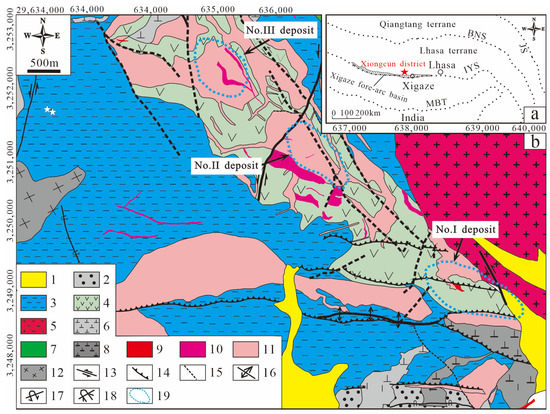
Figure 1.
Tectonic settings of Xiongcun Cu–Au ore district (a) and simple geological map of Xiongcun Cu–Au ore district showing sample locations (b) modified from [5,8]. 1—Quaternary; 2—Jurassic clastic and carbonate assemblage; 3—Lower Jurassic Xiongcun Formation volcanic sedimentary rocks; 4—Lower Jurassic Xiongcun Formation tuff; 5—Eocene biotite granodiorite; 6—Eocene quartz diorite; 7—Jurassic diabase; 8—Late Jurassic quartz diorite porphyry; 9—Middle Jurassic quartz diorite porphyry; 10—Early–Middle Jurassic quartz diorite porphyry; 11—Early Jurassic quartz diorite porphyry; 12—Jurassic hornblende gabbro; 13—Strike-slip fault; 14—Thrust fault; 15—Inferred fault; 16—Anticline; 17—Overturned Anticline; 18—Overturned syncline; 19—Orebody boundary; JS—Jinshajiang structure zone; BNS—Bangonghu–Nujiang structure zone; IYS—Indian river–Yaluzangbo structure zone; MBT—Main boundary thrust fault.
The potential role of F and Cl may affect the complexing and hence transport of Cu, Mo, Au, and other metals, so halogen chemistry is of broad interest in the study of hydrothermal deposits [10,11,12,13,14]. Biotite, which formed during either igneous crystallization or hydrothermal alteration, is an important mafic mineral in most magmatic–hydrothermal deposits [3,12,13,15,16,17]. The chemical composition of biotite is sensitive to the temperature, pressure, oxygen fugacity, and composition of the host magma and magmatic hydrothermal fluids [18,19,20,21]. The Fe/(Fe + Mg) ratio of biotite is controlled by the fO2 (oxygen fugacity) in the magmatic–hydrothermal system (Munoz, 1984; 1992). New equations (log[(fH2O/fHF)]fluid = 1000/T[2.37 + 1.1(Xphl)biotite] + 0.43 − log(XF/XOH)biotite, log[(fH2O/fHCl)]fluid = 1000/T[1.15 + 0.55(Xphl)biotite] + 0.68 − log(XCl/XOH)biotite, and log[(fHF/fHCl)]fluid = –1000/T[1.22 + 1.65(Xphl)biotite] + 0.25 + log(XF/XCl)biotite) are proposed for determining halogen fugacity ratios from biotite compositions [18] so that the chemistry of hydrothermal fluids in porphyry Cu systems can be evaluated in more detail [10,12,13,22,23,24,25,26]. Moreover, trace elements of biotite can be applied to trace the evolution of magmatic hydrothermal fluid [27,28,29,30], locate magmatic hydrothermal fluid centers [31], and evaluate barren and ore-forming intrusive rocks [32].
At Xiongcun, hydrothermal biotites, which are widely developed in the potassic and phyllic zones, are the main halogen-containing hydrothermal alteration minerals and can record key Geochemical information of porphyry-style hydrothermal activities. Reports on the halogen chemistry of the two individual hydrothermal fluids and the evolution of the halogen chemistry are scarce. In this study, the major and trace element compositions of biotite were analyzed by electron probe microanalysis (EPMA) and laser ablation–inductively coupled plasma–mass spectrometry (LA-ICP-MS) to investigate the differences in ore-forming fluid between the No. I and No. II deposits.
2. Deposit Geology
The Gangdese consists of the northern Gangdese subzone, central Gangdese subzone, and southern Gangdese subzone, which are bound by the Shiquan River–Nam Tso Mélange zone and Luobadui–Milashan fault. There are main three types of deposits in Gangdese: (1) porphyry Cu–Au deposits related to Neo-Tethys plate subduction (180–160 Ma), such as the Xiongcun and Dong’ga deposit [8,33]; (2) porphyry Mo deposits and skarn Pb–Zn and epithermal Au–Ag deposits related to in the extension of post-collision of Indian and Eurasian plates at 25~13 Ma, such as the Sharang, Hahaigang, Narusongduo, Xingaguo, and Mengya’a deposits [34,35,36]; and (3) post-collision porphyry and skarn Cu–polymetallic deposits (20–12 Ma), such as the Lakang’e, Qulong, Bangpu, and Jiama deposits [12,14,37,38].
Outcrops in the Xiongcun ore district consist of the Xiongcun Formation (J1−2x) conglomerate, siltstone, sandstone, argillite, carbonaceous shale, carbonaceous slate, volcanic breccia, lava, and limestone and Quaternary (Q) colluvium and alluvium (Figure 1b). The main structural feature at Xiongcun consists of trend E, NW, and NE faults (Figure 1b). The intrusive complex at Xiongcun can be divided into six intrusive phases according to U–Pb ages and crosscutting relationships, namely quartz diorite porphyry with U–Pb ages of 181 ± 1.5–175 ± 5 Ma [33], quartz diorite porphyry with U–Pb ages of 174 ± 1.6 Ma [39], quartz diorite with U–Pb ages of 167 ± 0.72–161 ± 0.66 Ma [33], diabase dykes with U–Pb ages of 165 ± 1.0 Ma [40], late Jurassic granodiorite porphyry, and Eocene biotite granodiorite and lamprophyre with U–Pb ages of 47 ± 0.61 Ma [41].
The Xiongcun ore district comprises three deposits, No. I, No. III, and No. III, which were formed by two mineralizing events. The molybdenite Re–Os age of the No. I deposit is 161.5 ± 2.7 Ma, and that of the No. II and No. III deposits is 172.6 ± 2.1 Ma [33,39]. The Cu/10,000*Au of the No. I deposit is 0.72, and that of the No. II deposit is 1.76.
2.1. No. I Deposit
The No. I deposit is mainly hosted in the Middle Jurassic quartz diorite porphyry (167–161 Ma) and the surrounding Xiongcun Formation tuff [8]. The quartz diorite porphyry associated with mineralization is intensely altered, and protolith texture and composition are poorly recognized.
The hydrothermal alterations of the No. I deposit are composed of potassic, phyllic, and propylitic alteration [42]. Potassic alteration, associated with Cu and Au mineralization, is characterized by the formation of biotite, andalusite, and minor magnetite and K-feldspar. Phyllic alteration, which is commonly superimposed with potassic alteration, is represented by fine grained quartz, sericite, and pyrite. Propylitic alteration is characterized by abundant hydrous minerals, including epidote, chlorite, and calcite.
2.2. No. II Deposit
The No. II deposit is hosted in the Early Jurassic quartz diorite porphyry and surrounding contemporary tuff [8,33]. The tuff is bedded and has a fine-grained texture. It hosts only a small amount of Cu–Au mineralization, which predominantly occurs in the Early Jurassic quartz diorite porphyry.
Hydrothermal alteration identified in the No. II deposit is composed of potassic, sodic–calcic, and minor phyllic and propylitic alteration [43]. Sodic–calcic alteration is characterized by the formation of albite, actinolite, epidote, chlorite, tourmaline, anhydrite, and quartz. Potassic alteration is represented by biotite, magnetite, and sulfides and is commonly superimposed with sodic–calcic alteration. Phyllic alteration is characterized by quartz, sericite, and pyrite. Propylitic alteration is represented by chlorite, epidote, sericite, and anhydrite.
3. Hydrothermal Biotite Types
Hydrothermal biotite from the No. I deposit occurs as anhedral–subhedral flakes or aggregates (<0.2 mm). Hydrothermal biotite from the No. I deposit is of two types: (1) quartz + sulfides + biotite veins, occurring as very medium- to coarse-grained flakes (Figure 2a–d); (2) disseminated secondary biotite, which is disseminated throughout the rock in the form of flakes or aggregates and is frequently intergrown with sphalerite, chalcopyrite, and muscovite (Figure 2e–i).
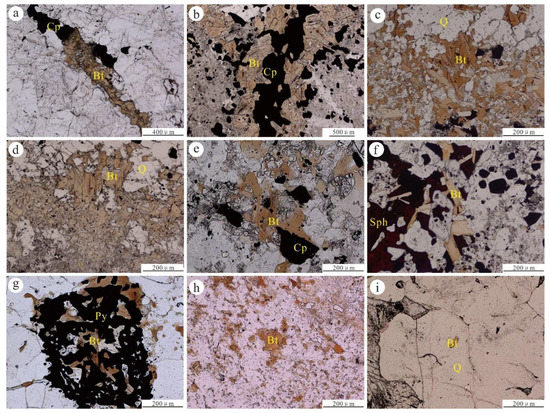
Figure 2.
Photomicrographs of hydrothermal biotites in the No. I deposit: (a,b) biotite + chalcopyrite vein; (c,d) quartz + biotite vein; (e) disseminated biotite intergrown with chalcopyrite; (f) disseminated biotite symbiosis with sphalerite; (g) disseminated biotite intergrown with pyrite; (h) disseminated biotite; (i) biotite in quartz phenocryst. Abbreviations: Bt—biotite, Q—quartz, Cp—chalcopyrite, Sph—sphalerite, Py—pyrite.
There are two types of hydrothermal biotite in the No. II deposit: (1) replacement biotite (typically < 0.05 mm), which is formed by the complete replacement of igneous hornblende and is in the form of aggregates of secondary flakes (Figure 3a–d); and (2) disseminated secondary biotite (typically < 0.1 mm), which takes the form of anhedral–subhedral crystals that are disseminated throughout the rock in the form of flakes or aggregates (Figure 3e–i).
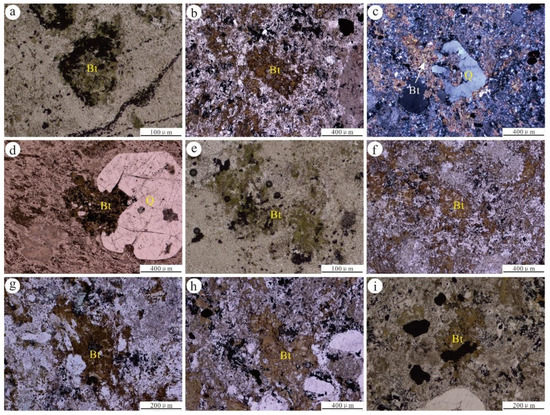
Figure 3.
Photomicrographs of hydrothermal biotites in the No. II deposit: (a,b) replacement biotite, formed by the complete replacement of igneous hornblende; (c–i) disseminated biotite. Abbreviations: Bt—biotite, Q—quartz.
4. Samples and Methods
The hydrothermal biotite samples are mainly from different drilling depths (Tables S1 and S2). Major element compositions and volatiles of biotite were determined by an Electron Probe Microanalyzer (EPMA) 1600 electron probe at the Tianjin Institute of Geology and Mineral Resources. The analytical conditions included an accelerating potential of 15 kV, 20 nA beam current, and 3 μm beam diameter, and the counting time was between 10 and 30 s.
Trace elements of biotite were determined using a laser ablation–inductively coupled plasma mass spectrometer at the State Key Laboratory of Ore Deposit Geochemistry, Institute of Geochemistry, Chinese Academy of Sciences. The analytical conditions included a fluence of 3 J cm−2, 30 μm laser spot, 8 Hz repetition rate, and 20 s duration for the gas blank and 40 s during sample ablation. Elemental contents were calibrated against multiple reference materials (NIST SRM 610, NISST SRM 612, and BCR-2G) without applying internal standardization [44]. The standard sample and the detection limits are listed in Table S4. Data reduction was performed using the ICPMSDataCal V9.5 software [44].
5. Results
5.1. Major Element Compositions and Volatiles
The major element compositions of biotite are listed in Tables S1 and S2. The F content of biotite varies widely, and some samples are below the detection limit. Hydrothermal biotite in the potassic alteration area of the No. I deposit is mainly phlogopite and minor Mg-biotite, and that in the phyllic alteration area of the No. I deposit is Mg-biotite (Figure 4). Hydrothermal biotite in the potassic alteration area of the No. II deposit is mainly Mg-biotite (Figure 4). The Mg-enriched biotites are characteristic of igneous rocks associated with porphyry copper deposits [10,12,13,22,23,24,25,26].

Figure 4.
Plot of Mg − Li vs. Fetot + Mn + Ti − AlVI classification diagram of [45].
Variations in major element compositions vs. XMg of various biotite types are shown in Figure 5. In Figure 5, XMg is positively correlated with SiO2 and Al2O3 and negatively correlated with FeOtot, and XMg is not obviously correlated with F and Cl. Hydrothermal biotite in the potassic alteration area of the No. I deposit is characterized by higher MgO, XMg, SiO2, and F contents and lower FeOtot, Al2O3, and Cl contents than those in the phyllic alteration area of the No. I deposit. Hydrothermal biotite from the No. I deposit is characterized by higher MgO, XMg, SiO2, MnO, and F contents and lower FeOtot, Al2O3, and Cl contents than those from the No. II deposit.
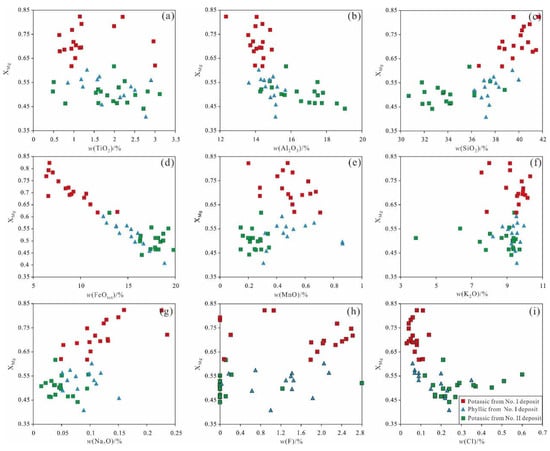
Figure 5.
Major element compositions of biotites from the Xiongcun ore district on (a) XMg – TiO2, (b) XMg – Al2O3, (c) XMg – SiO2, (d) XMg – FeOtot, (e) XMg – MnO, (f) XMg – K2O, (g) XMg – Na2O, (h) XMg – F, and (i) XMg – Cl plots.
5.2. Trace Element Compositions
The trace element compositions of biotite are listed in Table S3. The Mo, Cd, U, Be, and REE concentrations are extremely low and generally <1 ppm or below the detection limits (Table S3); most other trace element compositions in biotite are highly variable. The highest compositions are several orders of magnitude higher than the lowest compositions, e.g., for Li (6.0–514.1 ppm), Sc (15.1–150.4 ppm), Zn (66–1257 ppm), Rb (85–2947 ppm), Ga (26.8–80.6 ppm), Cs (8.9–247.6 ppm), Tl (12–205 ppm), V (51–690 ppm), Cr (0–111 ppm), and Ba (101–1048 ppm) (Table S3).
The contents of Nb and Ta in biotite are 0.4–29 ppm and 0.01–1.8 ppm, respectively, which indicate that they are mildly incompatible elements in biotite from the Xiongcun ore district (Table S3, Figure 6 and Figure 7). In addition, hydrothermal biotite from Xiongcun is enriched in V, Li, Zn, Rb, and Cs and depleted in Sr, Ba, Pb, Cu, and Mo compared with upper crust compositions (Table S3, Figure 7). Most elements in hydrothermal biotite from the No. I and No. II deposits overlap; however, hydrothermal biotite from the No. I deposit has significantly higher Li, Sc, Zn, Rb, Tl, and Pb contents and lower Ba, Cr, V, Co, Ni, Y, Sr, Zr, Th, and Cu contents than those of the No. II deposit (Table S3, Figure 6 and Figure 7).
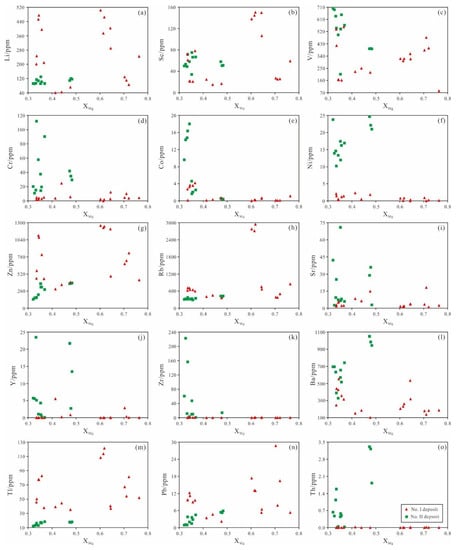
Figure 6.
Trace element compositions of biotites from the Xiongcun ore district on (a) Li − XMg, (b) Sc − XMg, (c) V − XMg, (d) Cr − XMg, (e) Co − XMg, (f) Ni − XMg, (g) Zn − XMg, (h) Rb − XMg, (i) Sr − XMg, (j) Y − XMg, (k) Zr − XMg, (l) Ba − XMg, (m) Tl − XMg, (n) Pb − XMg, and (o) Th − XMg plots.
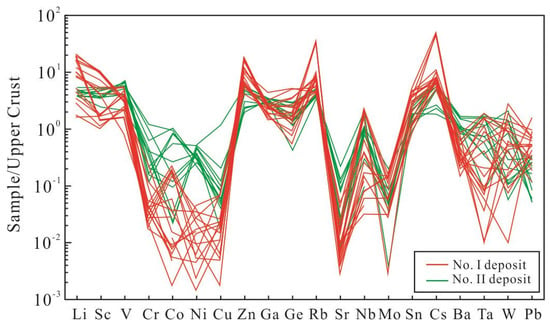
Figure 7.
Upper crust-normalized multi-element diagrams of biotite at Xiongcun ore district. Upper crust values are from [46].
6. Discussion
6.1. Biotite-Forming Conditions
6.1.1. Temperature
Biotite composition has been used to calculate the temperature and oxygen fugacity of magma [12,14,25,47,48]. Biotite geothermometric values for the potassic and phyllic alterations range from 351 °C to 593 °C (mean value = 458 °C) and 230 °C~337 °C (mean value = 297 °C), respectively, in the No. I deposit (Figure 8). Biotite geothermometric values for the potassic alteration range from 212 °C to 306 °C (mean = 253 °C) in the No. II deposit (Figure 8).
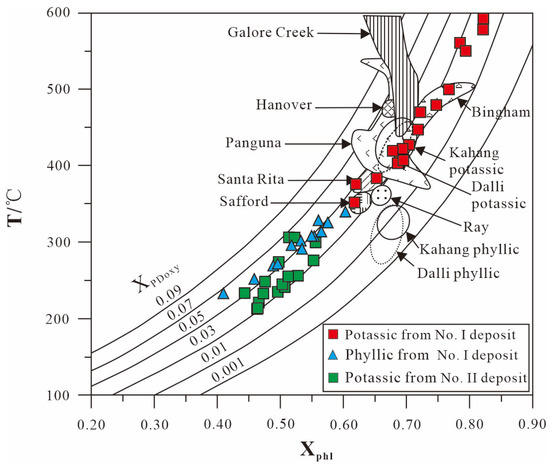
Figure 8.
Compositions of biotites from No. I and No. II deposits in [48]’s temperature (°C)–Xphl diagram. Contours show the fixed mole fractions of proton-deficient oxyannite. Analytical data for the plotting of other porphyry copper deposits including the Galore Creek, Santa Rita, Safford, Ray, and Hanover porphyry copper deposits are taken from [48]; data for the Panguna, Bingham, Dalli, and Kahang porphyry copper deposits are taken from [22,25,49,50], respectively.
6.1.2. Oxygen Fugacity
The oxygen fugacity (fO2) plays an important role in the speciation and solubility of sulfur and metal transport efficiency in magmatic–hydrothermal systems [12,14,28]. Mg2+ is more likely to occupy sites in biotite than Fe2+ in high-oxygen magmatic hydrothermal systems, so high XMg in biotite represents high oxygen fugacity in magmatic hydrothermal systems [12,14,25,47].
Hydrothermal biotite from the No. I deposit plots on or above the NNO buffer (Figure 9), while hydrothermal biotite from the No. II deposit plots on or above the QFM and NNO buffers (Figure 9), which indicates that the No. I deposit had higher oxygen fugacity than the No. II deposit. In addition, the Fe3+/Fe2+ ratio and XMg of hydrothermal biotite in the potassic alteration area of the No. I deposit are higher than those in the phyllic alteration area, which indicates higher oxygen fugacity in the potassic alteration area than in the phyllic alteration area.
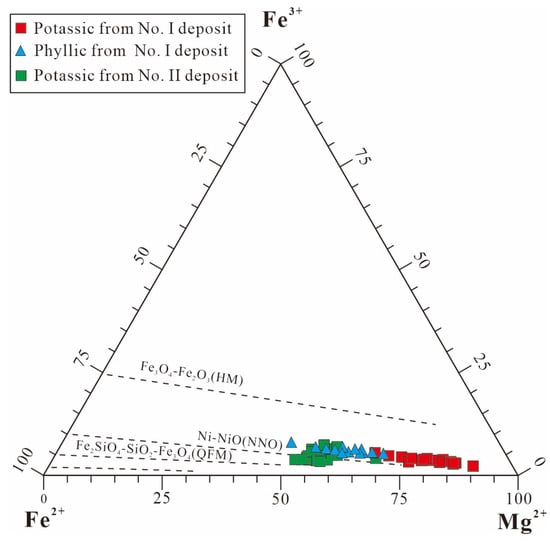
Figure 9.
Compositions of biotites from No. I and No. II deposits on the Fe3+–Fe2+–Mg diagram (from [47]).
6.1.3. Halogen Fugacity
For granitoid rocks containing no muscovite and fluorite, 70 to 90 percent F is contained in biotite, and 10 to 30 percent F is contained in amphibole, apatite, and titanite [13,28,51,52]. The halogen intercept values are temperature independent and represent the f(HCl)/f(HF) of the hydrothermal fluid [53,54,55]. To evaluate the relative degree of F and Cl enrichment in hydrothermal biotite at No. I and No. II deposits, log(XF/XOH), log(XCl/XOH), XMg, Xsid, and Xann of the biotite were used to calculate the halogen intercept values [IV(F), IV (Cl), and IV(F/Cl)], which are defined by [53] as:
where Xsid and Xann are obtained from the following Eqs. [55]:
IV(F) = 1.5XMg + 0.42Xann + 0.20Xsid − log(XF/XOH)
IV(Cl) = −5.01 − 1.93XMg − log(XCl/XOH)
IV(F/Cl) = IV(F) − IV(Cl)
Xsid = [(3 − Si/Al)/1.75][1 − XMg]
Xann = 1 − (XMg − Xsid)
The calculated IV(F), IV(Cl), and IV(F/Cl) values of hydrothermal biotite in the No. I and No. II deposits are shown in Tables S1 and S2, and the F content of some samples is 0 (below the detection limit), so the IV(F/Cl) and IV(F) values could not be calculated. Hydrothermal biotite in the No. I deposit has lower IV(F/Cl) and IV(F) and higher IV(Cl) than that in the No. II deposit. Comparisons of intercept values of F, Cl, and F/Cl in porphyry Cu and Mo–Sn–W deposits elsewhere with the No. I and No. II deposits are shown in Figure 10. Intercept values of F, Cl, and F/Cl of hydrothermal biotite from the No. I deposit are similar to those of other porphyry Cu deposits (Figure 10). The hydrothermal biotite from the No. II deposit has higher IV(F) and IV(F/Cl) than those of other porphyry Mo-/Cu deposits worldwide, which indicates that the No. I deposit is F- and Cl-rich, and the No. II deposit is Cl-rich and F-poor.
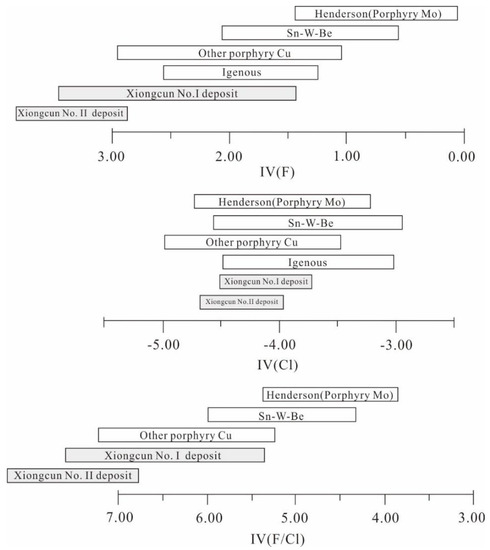
Figure 10.
Comparison of IV(F), IV(Cl), and IV(F/Cl) in Mo porphyries and Sn–W–Be and Cu porphyries with No. I and No. II deposits (from [26]). The compared data are from [53].
F and Cl play an important role in forming a porphyry deposit, such as in the transport of metals, so determining the relative halogen fugacity relations allows a more detailed evaluation of volatiles in magmatic–hydrothermal systems [10,13,14,18,53,56]. [18] proposed equations estimating the halogen fugacity relations based on the revised coefficients for F–Cl–OH partitioning between biotite and hydrothermal fluid [57,58]. These equations are as follows:
log[(fH2O/fHF)]fluid = 1000/T [2.37 + 1.1(Xphl)biotite] + 0.43 − log(XF/XOH)biotite
log[(fH2O/fHCl)]fluid = 1000/T [1.15 + 0.55(Xphl)biotite] + 0.68 − log(XCl/XOH)biotite
log[(fHF/fHCl)]fluid = −1000/T [1.22 + 1.65(Xphl)biotite] + 0.25 + log(XF/XCl)biotite
The calculated halogen fugacity ratios for hydrothermal fluids associated with the No. I and No. II deposits are shown in Tables S1 and S2, and the F content of some samples is 0 (below the detection limit), so log(fHF/fHCl) and log(fHF/fHCl) values could not be calculated. Hydrothermal biotites from the No. I deposit have higher log (fHF/fHCl) values and lower log (fH2O/fHF) values than those of the No. II deposit. The halogen fugacity ratios for hydrothermal fluids associated with the No. I deposit and other porphyry Mo-/Cu deposits are shown in Figure 11. Hydrothermal biotites from the phyllic alteration area have higher log (fH2O/fHF) and log (fH2O/fHCl) values and lower log (fHF/fHCl) values than those of the potassic alteration in the No. I deposit. The potassic alteration in the No. I deposit has two populations of fugacity ratios: one population has higher log(fHF/fHCl) and lower log(fH2O/fHF) values, and the other population has lower log(fHF/fHCl) and higher log(fH2O/fHF) values. The variable fugacity ratios in the No. I deposit may indicate that post hydrothermal fluids modified the biotite halogen compositions. However, the two groups of halogen fugacity ratios suggest that the No. I deposit was formed by two different hydrothermal fluids.
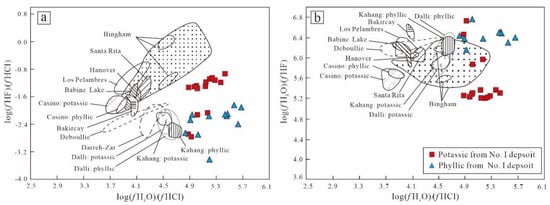
Figure 11.
Comparison of the No. I deposit with other porphyry systems in terms of: (a) log (fHF)/(fHCl) vs. log (fH2O)/(fHCl) and (b) log(fHF)/(fHCl) vs. log (fH2O)/(fHF) ratios. The fugacity ratios for the Santa Rita, Los Pelambres, Bakircay, Hanover, Bingham, Babine Lake, Casino, and Deboullie porphyry Cu deposits are from [10], Dalli from [22], Kahang from [25], and Darreh-Zar from [26].
The hydrothermal fluid related to the No. I deposit shows higher log(fH2O/fHCl) values and similar log(fHF/fHCl) and log (fH2O/fHF) values than those of fluids associated with other porphyry Mo-/Cu deposits worldwide. Hydrothermal biotites from the No. II deposit have lower log(fHF/fHCl) (<−4.0) and higher log(fH2O/fHF) (>6.8) values than those from the No. I deposit, and the F content of many samples is 0 (below the detection limit). This also indicates that the No. I deposit is F- and Cl-rich, similar to other porphyry Cu deposits, and the No. II deposit is also Cl-rich but relatively F-poor.
6.2. Metallogenic Implication of Biotite
The No. I deposit is characterized by abundant pyrrhotite and fluid inclusions containing plentiful CH4 and N2 [42], suggesting that the hydrothermal fluids were relatively reduced, likely a reduced porphyry Cu deposit [59]. The No. II deposit is similar to an oxidized porphyry copper deposit [60,61] given the abundant magnetite, anhydrite, and hematite. The Xiongcun ore district was formed by two individual mineralization events, according to the molybdenite Re–Os ages. The ore-bearing porphyries of the No. I deposit and No. II deposit have the same magma source given similar characteristics of whole-rock geochemistry and Sr–Nd–Pb–Hf isotopes [9], and apatite and zircon geochemistry [7], indicating that the two mineralization events are not the result of magma differences but of the differences in the evolution of ore-forming fluids, which is suggested by the biotite geochemistry and fluid inclusions of the No. I and No. II deposits.
The quartz diorite porphyry, which is the ore-bearing porphyry of the No. I deposit, is characterized by high fO2 values (>NNO) [42], indicating that the early ore-forming fluid had high oxygen fugacity. The magma and hydrothermal fluid of a reduced porphyry Cu deposit are both reduced [59], which is different from the No. I deposit. This indicates that the No. I deposit is not a reduced porphyry Cu deposit but rather an oxidized porphyry copper deposit. The biotite geochemistry of the No. I deposit indicates that the potassic fluid had high oxygen fugacity (>NNO) and that the oxidation state of ore-forming fluids decreased from potassic to phyllic. The two groups of halogen fugacity ratios suggest that the No. I deposit was formed by two different hydrothermal fluids. Therefore, CH4-rich formation fluids from the carbonaceous wall rocks [42] mixed with magmatic hydrothermal fluids, which resulted in a transition from an oxidizing to a reducing system and formed widespread occurrence of pyrrhotite, chalcopyrite, and molybdenite.
The No. II deposit contains abundant daughter crystal (magnetite, anhydrite, and hematite) inclusions [43], indicating that the early ore-forming fluid had high oxygen fugacity. However, the biotite geochemistry of the No. II deposit indicates that the oxygen fugacity (QFM~NNO) varies greatly, which may be due to mixing of magmatic fluids with meteoric water. The oxygen fugacity difference between the No. I and No. II deposits may indicate the extent of the reaction between the hydrothermal fluid and surrounding rock (Figure 12). The No. II deposit predominantly occurs in the quartz diorite porphyry (Figure 12). However, the No. I deposit is mainly hosted in the quartz diorite porphyry and the surrounding tuff, which are due more likely to mix with reducing fluid.
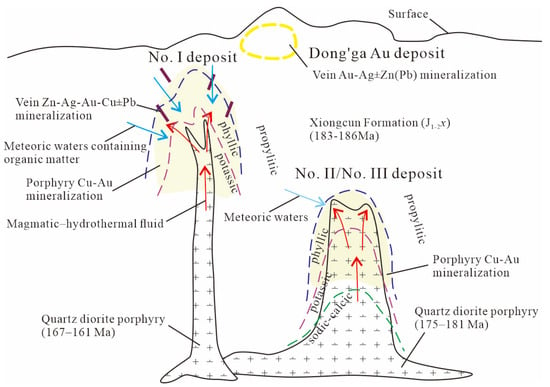
Figure 12.
Schematic model of the Xiongcun porphyry Cu–Au ore district.
The biotites from the No. I deposit have significantly higher F, Li, Zn, and Pb contents and lower, Cl Cr, Co, Ni contents than the biotites from the No. II deposit. Cr, Co, and Ni mainly come from the mantle, and F, Li, and Zn mainly come from the crust. Hence, the hydrothermal fluid associated with the No. II deposit had more of a mantle source (they may contain more copper and gold), while the hydrothermal fluid of the No. I deposit may have been mixed with meteoric waters, resulting in lower Cr, Co, and Ni contents. The resources of the No. I deposit are 103.6 Mt Cu and 143.3 t Au, and those of the No. II deposit are 134.4 Mt Cu and 76.3 t Au. The Cu/10,000*Au of the No. I deposit is 0.72, and that of the No. II deposit is 1.76. The hydrothermal fluid of the No. I deposit was mixed with meteoric waters containing plentiful CH4, resulting in a decrease in the oxygen fugacity and more efficient precipitation of gold.
For magmatic–hydrothermal systems, volatile components (such as F and Cl) may play a potential role in the timing of vapor saturation, complexing with metals, and control of the compositional variations and mineralization type [56,62]. Cl-rich hydrothermal fluids are conducive to removal of Cu from a melt and its transport by complexing with Cu in ore-forming fluids [63,64,65,66,67]. Numerous empirical observations of Au deposits suggest that high temperature Cl-rich hydrothermal fluids can effectively transport Au [11,68,69,70], as proved by high-T experiments [68]. The chlorine complexing with copper and gold (CuCl2− and AuCl2−) plays an important role in the migration and precipitation of Cu and Au [71]. The Xiongcun No. I and No. II deposits were formed by Cl-rich hydrothermal fluids conducive to transporting Cu and Au. The decreasing Cl from potassic to phyllic indicates a low Cu and Au transport capacity in the phyllic stage, which may have resulted in Cu and Au mineralization.
7. Conclusions
(1) Hydrothermal biotite from the No. I deposit is Mg-rich, plotting in the phlogopite and Mg-biotite compositional fields, and hydrothermal biotite from the No. II deposit plots in the Mg-biotite compositional fields. Hydrothermal biotite from the No. I deposit has significantly higher SiO2, MnO, MgO, F, Li, Sc, Zn, Rb, Tl, and Pb contents and lower Al2O3, FeOtot, Cl, V, Cr, Co, Ni, Sr, Y, Zr, Ba, Th, and Cu contents than the biotite from the No. II deposit.
(2) Hydrothermal biotite geothermometry yields a temperature range from 230 °C to 593 °C for the No. I deposit and 212 °C to 306 °C for the No. II deposit. The hydrothermal fluid of the No. I deposit has higher oxygen fugacity (>NNO) and log(fHF/fHCl) values and lower log(fH2O/fHF) values and is F- and Cl-rich; the hydrothermal fluid of the No. II deposit has lower oxygen fugacity (QFM~NNO) and log(fHF/fHCl) values and higher log(fH2O/fHF) values and is Cl-rich and F-poor.
(3) The biotite geochemistry shows that the No. I deposit and No. II deposit formed from different hydrothermal fluids. The hydrothermal fluid of the No. I deposit was mixed with meteoric waters containing organic matter, resulting in a decrease in the oxygen fugacity and more efficient precipitation of gold. The No. I and No. II deposits were formed by Cl-rich hydrothermal fluids conducive to transporting Cu and Au. The decreasing Cl, oxygen fugacity, and temperature may be the key factors in Cu and Au precipitation.
Supplementary Materials
The following supporting information can be downloaded at: https://www.mdpi.com/article/10.3390/min13070876/s1, Table S1. Representative electron-microprobe analyses of biotite from No. I deposit at Xiongcun; Table S2. Representative electron-microprobe analyses of biotite from No. II depsoit at Xiongcun; Table S3. Representative LA-ICP-MS analyses of biotite from No. I deposit and No. II depsoit at Xiongcun; Table S4. The detection limits of test sample and standard sample.
Author Contributions
Writing—original draft, P.T.; Funding acquisition, J.T.; Investigation, X.L.; Writing—review & editing, B.L.; Methodology, F.X.; Project administration, M.S.; Supervision, F.L.; Formal analysis, J.Q. and H.C.; Data curation, M.W., Y.X. and G.T. All authors have read and agreed to the published version of the manuscript.
Funding
This research was funded by the National Key R&D Program of China (grant number 2022YFC2905004); the Natural Science Foundation of Sichuan (grant number 2023NSFSC0791); Research Fund of Southwest University of Science and Technology (grant number 22zx7127); the National Natural Science Foundation of China (42272093, 42230813).
Data Availability Statement
Our research data can be found in Supplementary Materials.
Acknowledgments
We thank two anonymous reviewers for their constructive comments and suggestions lead to further improvement of this manuscript.
Conflicts of Interest
The authors declare no conflict of interest.
References
- Hou, Z.Q.; Cook, N.J. Metallogenesis of the Tibetan collisional orogeny: A review and introduction to the special issue. Ore Geol. Rev. 2009, 36, 2–24. [Google Scholar] [CrossRef]
- Tang, J.X.; Wang, Q.; Yang, H.H.; Gao, X.; Zhang, Z.B.; Zou, B. Mineralization, exploration and resource potential of porphyry-skarn-epithermal copper polymetallic deposits in Tibet. Acta Geosci. Sin. 2017, 38, 571–613, (In Chinese with English abstract). [Google Scholar]
- Lin, B.; Tang, J.X.; Chen, Y.C.; Song, Y.; Hall, G.; Wang, Q.; Yang, C.; Fang, X.; Duan, J.L.; Yang, H.H.; et al. Geochronology and genesis of the tiegelongnan porphyry Cu(Au) deposit in Tibet: Evidence from U-Pb, Re-Os Dating and Hf, S, and H-O isotopes. Resour. Geol. 2017, 67, 1–21. [Google Scholar] [CrossRef]
- Lin, B.; Chen, Y.C.; Tang, J.X.; Wang, Q.; Song, Y.; Yang, C.; Wang, W.L.; He, W.; Zhang, L.J. 40Ar/39Ar and Rb-Sr ages of the Tiegelongnan porphyry Cu-(Au) deposit in the Bangong Co-Nujiang Metallogenic Belt of Tibet, China: Implication for generation of super-large deposit. Acta Geol. Sin. (Engl. Ed.) 2017, 91, 602–616. [Google Scholar] [CrossRef]
- Lang, H.; Wang, X.H.; Deng, Y.L.; Tang, J.X.; Xie, F.W.; Zhou, Y.; Huang, Y.; Li, Z.; Yin, Q.; Jiang, K. Early Jurassic volcanic rocks in the Xiongcun district, southern Lhasa subterrane, Tibet: Implications for the tectono-magmatic events associated with the early evolution of the Neo-Tethys Ocean. Lithos 2019, 340–341, 166–180. [Google Scholar] [CrossRef]
- Lang, X.H.; Deng, Y.L.; Wang, X.H.; Tang, J.X.; Yin, Q.; Xie, F.W.; Yang, Z.Y.; Li, Z.; He, Q.; Li, L.; et al. Geochronology and geochemistry of volcanic rocks of the Bima Formation, southern Lhasa subterrane, Tibet: Implications for early Neo-Tethyan sunduction. Gondwana Res. 2020, 80, 335–349. [Google Scholar] [CrossRef]
- Xie, F.W.; Tang, J.X.; Chen, Y.C.; Lang, X.H. Apatite and zircon geochemistry of Jurassic porphyries in the Xiongcun district, southern Gangdese porphyry copper belt: Implications for petrogenesis and mineralization. Ore Geol. Rev. 2018, 96, 98–114. [Google Scholar] [CrossRef]
- Tang, J.X.; Lang, X.H.; Xie, F.W.; Gao, Y.M.; Li, Z.J.; Huang, Y.; Ding, F.; Yang, H.H.; Zhang, L.; Wang, Q.; et al. Geological characteristics and genesis of the Jurassic No. I porphyry Cu–Au deposit in the Xiongcun district, Gangdese porphyry copper belt, Tibet. Ore Geol. Rev. 2015, 70, 438–456. [Google Scholar] [CrossRef]
- Lang, X.H.; Guo, W.B.; Wang, X.H.; Deng, Y.L.; Yang, Z.Y.; Xie, F.W.; Li, Z.; Zhang, Z.; Jiang, K. Petrogenesis and tectonic implications of the ore-bearing porphyries in the Xiongcun district: Constraints from the geochronology and geochemistry. Acta Petrol. Sin. 2019, 35, 2105–2123, (In Chinese with English abstract). [Google Scholar]
- Selby, D.; Nesbitt, B.E. Chemical composition of biotite from the Casino porphyry Cu–Au–Mo mineralization, Yukon, Canada: Evaluation of magmatic and hydrothermal fluid chemistry. Chem. Geol. 2000, 171, 77–93. [Google Scholar] [CrossRef]
- Coulson, I.M.; Dipple, G.M.; Raudsepp, M. Evolution of HF and HCl activity in magmatic volatiles of the gold-mineralized Emerald Lake pluton, Yukon Territory, Canada. Miner. Depos. 2001, 36, 594–606. [Google Scholar] [CrossRef]
- Tang, P.; Tang, J.X.; Lin, B.; Wang, L.Q.; Zheng, W.B.; Leng, Q.F.; Gao, X.; Zhang, Z.B.; Tang, X.Q. Mineral chemistry of magmatic and hydrothermal biotites from the Bangpu porphyry Mo (Cu) deposit, Tibet. Ore Geol. Rev. 2019, 115, 103122. [Google Scholar] [CrossRef]
- Tang, P.; Chen, Y.C.; Tang, J.X.; Wang, Y.; Zheng, W.B.; Leng, Q.F.; Lin, B.; Wu, C.N. Advances in research of mineral chemistry of magmatic and hydrothermal biotites. Acta Geol. Sin. (Engl. Ed.) 2019, 93, 1947–1966. [Google Scholar] [CrossRef]
- Tang, P.; Tang, J.X.; Wang, Y.; Lin, B.; Leng, Q.F.; Zhang, Q.Z.; He, L.; Zhang, Z.B.; Sun, M.; Wu, C.N.; et al. Genesis of the Lakang’e porphyry Mo (Cu) deposit, Tibet: Constraints from geochemistry, geochronology, Sr-Nd-Pb-Hf isotopes, zircon and apatite. Lithos 2021, 380–381, 1–38. [Google Scholar] [CrossRef]
- Sun, Z.J.; Fang, W.X.; Lu, J.; Guo, Y.Q.; Song, L.H. Mineral Geochemiscal Characteristics and Indication Significance of Biotite—Rutile in the Gabbro Intrusions in the Yinmin Iron-Copper District, Yunnan. Acta Geol. Sin. (Engl. Ed.) 2017, 91 (Suppl. S1), 224–226. [Google Scholar] [CrossRef]
- Lin, B.; Tang, J.X.; Chen, Y.C.; Michael, B.; Song, Y.; Yang, H.H.; Wang, Q.; He, W.; Liu, Z.B. Geology and geochronology of Naruo large porphyry–breccia Cu deposit in the Duolong district, Tibet. Gondwana Res. 2018, 66, 168–182. [Google Scholar] [CrossRef]
- Feng, Y.Z.; Deng, C.Z.; Xiao, B.; Gong, L.; Yin, R.S.; Sun, D.Y. Biotite geochemistry and its implication on the temporal and spatial difference of Cu and Mo mineralization at the Xiaokele porphyry Cu-Mo deposit, NE China. Ore Geol. Rev. 2021, 139, 104508. [Google Scholar] [CrossRef]
- Munoz, J.L. Calculation of HF and HCl fugacities from biotite compositions: Revised equations. Geol. Soc. Am. Abstr. Programs 1992, 24, A221. [Google Scholar]
- Abdel-Rahman, A.M. Nature of biotites from alkaline, calc-alkaline, and peraluminous magmas. J. Petrol. 1994, 35, 525–541. [Google Scholar] [CrossRef]
- Webster, J.D. The exsolution of magmatic hydrosaline chloride liquids. Chem. Geol. 2004, 210, 33–48. [Google Scholar] [CrossRef]
- Siahcheshm, K.; Calagari, A.A.; Abedini, A.; Lentz, D.R. Halogen signatures of biotites from the Maher-Abad porphyry copper deposit, Iran: Characterization of volatiles in syn-to post-magmatic hydrothermal fluids. Int. Geol. Rev. 2012, 54, 1353–1368. [Google Scholar] [CrossRef]
- Ayati, F.; Yavuz, F.; Noghreyan, M.; Haroni, H.A.; Yavuz, R. Chemical characteristics and composition of hydrothermal biotite from the Dalli porphyry copper prospect, Arak, central province of Iran. Mineral. Petrol. 2008, 94, 107–122. [Google Scholar] [CrossRef]
- Boomeri, M.; Nakashima, K.; Lentz, D.R. The Sarcheshmeh porphyry copper deposit, Kerman, Iran: A mineralogical analysis of the igneous rocks and alteration zones including halogen element systematics related to Cu mineralization processes. Ore Geol. Rev. 2010, 38, 367–381. [Google Scholar] [CrossRef]
- Boomeri, M.; Nakashima, K.; Lentz, D.R. The Miduk porphyry Cu deposit, Kerman, Iran: A geochemical analysis of the potassic alteration including halogen element systematics related to Cu mineralization processes. J. Geochem. Explor. 2009, 103, 17–29. [Google Scholar] [CrossRef]
- Afshooni, S.Z.; Mirnejad, H.; Esmaeily, D.; Haroni, H.A. Mineral chemistry of hydrothermal biotite from the Kahang porphyry copper deposit (NE Isfahan), Central Province of Iran. Ore Geol. Rev. 2013, 54, 214–232. [Google Scholar] [CrossRef]
- Parsapoor, A.; Khalili, M.; Tepley, F.; Maghami, M. Mineral chemistry and isotopic composition of magmatic, reequilibrated and hydrothermal biotites from Darreh-Zar porphyry copper deposit, Kerman (Southeast of Iran). Ore Geol. Rev. 2015, 66, 200–218. [Google Scholar] [CrossRef]
- Fedele, L.; Lustrino, M.; Melluso, L.; Morra, V.; Zanetti, A.; Vannucci, R. Trace-element partitioning between plagioclase, alkali feldspar, Ti-magnetite, biotite, apatite, and evolved potassic liquids from Campi Flegrei (Southern Italy). Am. Mineral. 2015, 100, 233–249. [Google Scholar] [CrossRef]
- Zhang, W.; Lentz, D.R.; Thorne, K.G.; McFarlane, C. Geochemical characteristics of biotite from felsic intrusive rocks around the Sisson Brook W-Mo-Cu deposit, west-central New Brunswick: An indicator of halogen and oxygen fugacity of magmatic systems. Ore Geol. Rev. 2016, 77, 82–96. [Google Scholar] [CrossRef]
- Sun, K.; Chen, B.; Deng, J. Biotite in highly evolved granites from the Shimensi W-Cu-Mo polymetallic ore deposit, China: Insights into magma source and evolution. Lithos 2019, 350–351, 105245. [Google Scholar] [CrossRef]
- Li, J.X.; Fan, W.M.; Zhang, L.Y.; Ding, L.; Yue, Y.H.; Xie, J.; Cai, F.L.; Quan, Q.Y.; Sein, K. Biotite geochemistry deciphers magma evolution of Sn-bearing granite, southern Myanmar. Ore Geol. Rev. 2020, 121, 103565. [Google Scholar] [CrossRef]
- Yu, K.L.; Li, G.M.; Zhao, J.X.; Evans, N.J.; Li, J.X.; Jiang, G.W.; Zou, X.Y.; Qin, K.Z.; Guo, H. Biotite composition as a tracer of fluid evolution and mineralization center: A case study at the Qulong porphyry Cu-Mo deposit, Tibet. Miner. Depos. 2022, 57, 1047–1069. [Google Scholar] [CrossRef]
- Azadbakht, Z.; Lentz, D.R.; McFarlane, C.R.M.; Whalen, J.B. Using magmatic biotite chemistry to differentiate barren and mineralized Silurian-Devonian granitoids of New Brunswick, Canada. Contrib. Mineral. Petrol. 2020, 175, 69. [Google Scholar] [CrossRef]
- Lang, X.H.; Tang, J.X.; Li, Z.J.; Huang, Y.; Ding, F.; Yang, H.H.; Xie, F.W.; Zhang, L.; Wang, Q.; Zhou, Y. U-Pb and Re–Os geochronological evidence for the Jurassic porphyry metallogenic event of the Xiongcun district in the Gangdese porphyry copper belt, southern Tibet, PRC. J. Asian Earth Sci. 2014, 79, 608–622. [Google Scholar] [CrossRef]
- Tang, J.X.; Chen, Y.C.; Wang, D.H.; Wang, C.H.; Xu, Y.P.; Qu, W.J.; Huang, W.; Huang, Y. Re–Os Dating Molybdenite from the Sharang porphyry molybdenum deposit in Gongbógyamda county, Tibet and its geological significance. Acta Geol. Sin. 2009, 83, 698–704, (In Chinese with English abstract). [Google Scholar]
- Wang, L.Q.; Tang, J.X.; Deng, J.; Kang, H.R.; Lin, B.; Cheng, W.B.; Li, Z.; Zhang, Z. The Longmala and Mengya’a skarn Pb–Zn deposits, Gangdese region, Tibet: Evidence from U–Pb and Re–Os geochronology for formation during early India–Asia collision. Int. Geol. Rev. 2015, 57, 1825–1842. [Google Scholar] [CrossRef]
- Tang, P.; Tang, J.X.; Wang, Y.; Lin, B.; Zheng, W.B.; Leng, Q.F.; Zhang, Z.B.; Yang, Y.; Wu, C.N.; Qi, J.; et al. Zircon U-Pb geochronology, geochemistry, S-Pb-Hf isotopic compositions, and mineral chemistry of the Xin’gaguo skarn Pb-Zn deposit, Tibet, China. Geol. J. 2020, 55, 4790–4809. [Google Scholar] [CrossRef]
- Yang, Z.M.; Hou, Z.Q.; White, N.C.; Chang, Z.S.; Li, Z.Q.; Song, Y. Geology of the post-collisional porphyry copper–molybdenum deposit at Qulong, Tibet. Ore Geol. Rev. 2009, 36, 133–159. [Google Scholar] [CrossRef]
- Zheng, W.B.; Tang, J.X.; Zhong, K.H.; Ying, L.J.; Leng, Q.F.; Ding, S.; Lin, B. Geology of the Jiama porphyry copper–polymetallic system, Lhasa Region, China. Ore Geol. Rev. 2016, 74, 151–169. [Google Scholar] [CrossRef]
- Lang, X.H.; Tang, J.X.; Xie, F.W.; Li, Z.J.; Huang, Y.; Ding, F.; Yang, H.H.; Zhou, Y.; Wang, Q. Geochronology and geochemistry of the southern porphyry in the Xiongcun district, Tibet and its geological implications. Geotecton. Metallog. 2014, 38, 609–620, (In Chinese with English abstract). [Google Scholar]
- Lang, X.H.; Wang, X.H.; Tang, J.X.; Deng, Y.L.; Cui, Z.W.; Yin, Q.; Xie, F.W. Composition and age of Jurassic diabase dikes in the Xiongcun porphyry copper–gold district, southern margin of the Lhasa terrane, Tibet, China: Petrogenesis and tectonic setting. Geol. J. 2017, 2017, 1–21. [Google Scholar] [CrossRef]
- Lang, X.H.; Tang, J.X.; Yin, Q.; Cui, Z.W.; Huang, Y.; Zhang, J.S.; Gao, Y.M.; Li, Z.J.; Ding, F.; Xie, F.W.; et al. Geochemistry and genesis of Eocene lamprophyres in the Xiongcun porphyry copper–gold district, southern margin of the Lhasa terrane, Tibet, China. Geol. Mag. 2017, 51, 123–142. [Google Scholar] [CrossRef]
- Lang, X.H.; Deng, Y.L.; Wang, X.H.; Tang, J.X.; Xie, F.W.; Yang, Z.Y.; Yin, Q.; Jiang, K. Reduced fluids in porphyry copper-gold systems reflect the occurrence of the wall-thermogenic process: An example from the No.1 deposit in the Xiongcun district, Tibet, China. Ore Geol. Rev. 2020, 118, 103212. [Google Scholar] [CrossRef]
- Lang, X.H.; Deng, Y.L.; Wang, X.H.; Tang, J.X.; Xie, F.W.; Yang, Z.Y.; Yin, Q.; Jiang, K. Hydrothermal evolution and ore precipitation of the No. 2 porphyry Cu–Au deposit in the Xiongcun district, Tibet: Evidence from cathodoluminescence, fluid inclusions, and isotopes. Ore Geol. Rev. 2019, 114, 103141. [Google Scholar] [CrossRef]
- Liu, Y.S.; Hu, Z.C.; Gao, S.; Günther, D.; Xu, J.; Gao, C.G.; Chen, H.H. In situ analysis of major and trace elements of anhydrous minerals by LA–ICP–MS without applying an internal standard. Chem. Geol. 2008, 257, 34–43. [Google Scholar] [CrossRef]
- Tischendorf, G.; Gottesmann, B.; Förster, H.J.; Trumbull, R.B. On Li-bearing micas: Estimating Li from electron microprobe analyses and an improved diagram for graphical representation. Miner. Mag. 1997, 61, 809–834. [Google Scholar] [CrossRef]
- Rudnick, R.L.; Gao, S. Composition of the continental crust. In Treatise on Geochemistry; Holland, H.D., Turekian, K.K., Eds.; Pergamon: Oxford, UK, 2003; pp. 1–64. [Google Scholar]
- Wones, D.R.; Eugster, H.P. Stability of biotiteexperiment theory and application. Am. Mineral. 1965, 50, 1228. [Google Scholar]
- Beane, R.E. Biotite stability in the porphyry copper environment. Econonic Geol. 1974, 69, 241–256. [Google Scholar] [CrossRef]
- Ford, J.H. A chemical study of alteration at the Panguna porphyry copper deposit, Bougainville, Papua New Guinea. Econ. Geol. 1978, 73, 703–720. [Google Scholar] [CrossRef]
- Lanier, G.; Raab, W.J.; Folsom, R.B.; Cone, S. Alteration of equigranular monzonite, Bingham mining district, Utah. Econ. Geol. 1978, 73, 1270–1286. [Google Scholar] [CrossRef]
- Grabezkev, A.I.; Vigorova, V.G.; Chashukhina, V.A. Behavior of fluorine during crystallization of granites (in connection with validation of the criteria of granite specialization). Geochem. Int. 1979, 16, 23–33. [Google Scholar]
- Speer, J.A. Micas in igneous rocks. Rev. Mineral. Geochem. 1984, 13, 299–356. [Google Scholar]
- Munoz, J.L. F-OH and Cl-OH exchange in micas with applications to hydrothermal ore deposits. Rev. Mineral. Geochem. 1984, 13, 469–493. [Google Scholar]
- Van Middelaar, W.T.; Keith, J.D. Mica chemistry as an indicator of oxygen and halogen fugacities in the CanTung and other W-related granitoids in the North American Cordillera. Geol. Soc. Am. Spec. Pap. 1990, 246, 205–220. [Google Scholar]
- Yavuz, F. Evaluating micas in petrologic and metallogenic aspect: I–definitions and structure of the computer program MICA. Comput. Geosci. 2003, 29, 1215–1228. [Google Scholar] [CrossRef]
- Loferski, P.J.; Ayuso, R.A. Petrography and mineral chemistry of the composite Deboullie pluton, northern Maine, USA: Implications for the genesis of Cu–Mo mineralization. Chem. Geol. 1995, 123, 89–105. [Google Scholar] [CrossRef]
- Zhu, C.; Sverjensky, D.A. Partitioning of F-Cl-OH between minerals and hydrothermal fluids. Geochim. Cosmochim. Acta 1991, 55, 1837–1858. [Google Scholar] [CrossRef]
- Zhu, C.; Sverjensky, D.A. F-Cl-OH partitioning between biotite and apatite. Geochim. Cosmochim. Acta 1992, 56, 3435–3467. [Google Scholar] [CrossRef]
- Rowins, S.M. Reduced porphyry copper–gold deposits: A new variation on an old theme. Geology 2000, 28, 491–494. [Google Scholar] [CrossRef]
- Sillitoe, R.H. Porphyry copper systems. Econ. Geol. 2010, 105, 3–41. [Google Scholar] [CrossRef]
- Hedenquist, J.; Lowenstern, J. The role of magmas in the formation of hydrothermal ore deposits. Nature 1994, 370, 519–527. [Google Scholar] [CrossRef]
- Pirajno, F. A review of the geology and geodynamic evolution of the Palaeoproterozoic Earaheedy Basin, Western Australia. Earth Sci. Rev. 2009, 94, 39–77. [Google Scholar] [CrossRef]
- Candela, P.A.; Holland, H.D. The partitioning of copper and molybdenum between silicate melts and aqueous fluids. Geochim. Cosmochim. Acta 1984, 48, 373–380. [Google Scholar] [CrossRef]
- Keppler, H.; Wyllie, P.J. Partitioning of Cu, Sn, Mo, W, U, and Th between melt and aqueous fluid in the systems haplogranite–H2O–HCl and haplogranite–H2O–HF. Contrib. Mineral. Petrol. 1991, 109, 139–150. [Google Scholar] [CrossRef]
- Ruaya, J.R. Estimation of instability constants of metal chloride complexes in hydrothermal solutions up to 300 °C. Geochim. Cosmochim. Acta 1988, 52, 1983–1996. [Google Scholar] [CrossRef]
- Xiao, Z.; Gammons, C.H.; Williams-Jones, A.E. Experimental study of copper (I) chloride complexing in hydrothermal solutions at 40 to 300 °C and saturated vapor pressure. Geochim. Cosmochim. Acta 1998, 62, 2949–2964. [Google Scholar] [CrossRef]
- Bai, T.B.; van Groos, A.F.K. The distribution of Na, K, Rb, Sr, Al, Ge, Cu, W, Mo, La, and Ce between granitic melts and coexisting aqueous fluids. Geochim. Cosmochim. Acta 1999, 63, 1117–1131. [Google Scholar] [CrossRef]
- Gammons, C.H.; Williams-Jones, A.E. Chemical mobility of gold in the porphyry-epithermal environment. Econ. Geol. 1997, 92, 45–59. [Google Scholar] [CrossRef]
- Muller, D.; Groves, D.I. Potassic Igneous Rocks and Associated Gold-Copper Mineralization; Springer: Berlin/Heidelberg, Germany, 2000; p. 252. [Google Scholar]
- Groves, D.I.; Goldfarb, R.J.; Robert, F.; Hart, C.J.R. Gold deposits in metamorphic belts: Overview of current understanding, outstanding problems, future research, exploration significance. Econ. Geol. 2003, 98, 1–29. [Google Scholar]
- Idrus, A.; Kolb, J.; Meyer, F.M. Chemical composition of rockforming minerals in copper-gold-bearing tonalite porphyries at the Batu Hijau Deposit, Sumbawa Island, Indonesia: Implications for crystallization conditions and fluorine-chlorine fugacity. Resour. Geol. 2007, 57, 102–113. [Google Scholar] [CrossRef]
Disclaimer/Publisher’s Note: The statements, opinions and data contained in all publications are solely those of the individual author(s) and contributor(s) and not of MDPI and/or the editor(s). MDPI and/or the editor(s) disclaim responsibility for any injury to people or property resulting from any ideas, methods, instructions or products referred to in the content. |
© 2023 by the authors. Licensee MDPI, Basel, Switzerland. This article is an open access article distributed under the terms and conditions of the Creative Commons Attribution (CC BY) license (https://creativecommons.org/licenses/by/4.0/).